Vantec NXP-201 and Vantec Fans review
Since case modding started to become popular a few years ago the market has been flooded with all kinds of fan controllers. In this review, we will take a closer look at the Vantec NXP-201 fan controller and we'll also have a very quick look at Vantec's Tornado and ThermoFlow fans.Here's a photo of the box in which the Vantec NXP-201 ships and also a quick look at the device:
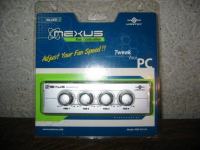
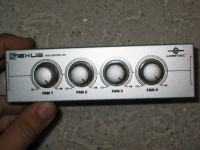
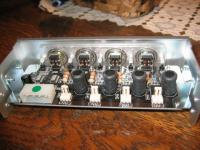
Features and Specifications of the NXP-201:
Model: NXP-201-SL, NXP-201-BK
Input Voltage: 12V +-10%
Output Voltage: 7V +-20% ~ 12V +-5%
Output Current: Up to 1.5A
Outline Dimension: 148.5 X 41.5 X 62.5mm
Weight: 150gm
This fan controller from Vantec is available in two versions: one with a black and one with a silver housing. The housing is made of Aluminum. The NXP-201 has 4 channels, and you can connect fans (or other devices like CCFLs) to the 3-pin connectors on the rear of the device. Luckily, Vantec also ships two 3-pin extension cables and two 3-pin to 4-pin(Molex) cables with the NXP-201.
The knobs on the front allow you to change the voltage on each of the channels from 7V to 12V. Something that I'm missing here is the ability to turn a fan off. The frontpanel looks pretty nice I think, it has a fairly professional look.
Each of the four channels supports 15 to 18 Watts according to Vantec. A simple 80mm fan draws about 1W to 2W. But some more advanced fans like the Vantec Tornado's draw a lot more: the 92mm Tornado draws up to 12.5W. Except for fans you can also connect other devices to these channels, for instance cold cathodes will also give a nice effect.
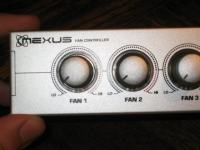
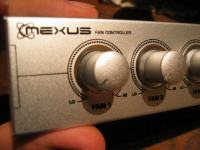
The following pictures show some of the included cables. Like I already mentioned before Vantec ships two 3-pin extension cables and two 3-pin to 4-pin cables with these fan controllers.
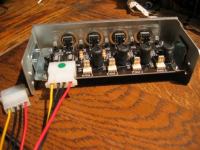
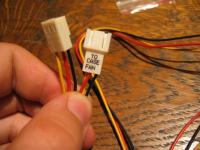
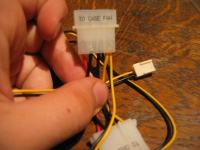
And here you can see the NXP-201 in action. Each of the four knobs is accentuated by blue LED light.
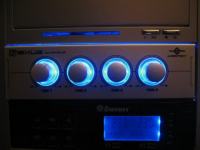
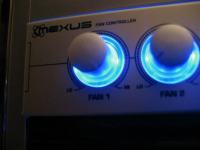
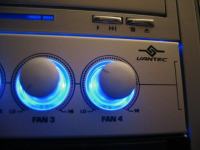
The technology used for this fan controller is PWM and not the regular linear regulation. PWM (pulse width modulation) has a few advantages but also a few drawbacks.
With linear regulation when you adjust the channel to 7V it will raise the resistance so that the voltage will drop. This creates a constant of 7V, but it also creates heat which needs to be dissipated.
PWM works differently: this technology gives the fan a rapid stream of 12V taps. By adjusting the channel you can control the speed at which these taps occur. The advantage of this technology is that is doesn't create any heat. But there is a serious downside, the PWM circuitry can produce a buzz at certain fan speeds. If you are interested in knowing how this technology works then check out this page for additional details.
I looked into this issue and for me, the buzz is hardly noticeable when I'm sitting in front of my PC. Only when I get close to the fan controller I can hear a small buzz when I turn the channel to 3/4th. Under normal conditions, I can't notice it.
Conclusion:
Like most fan controllers on the market, this one does its work perfectly. To be honest there can not be much wrong with a simple device like a fan controller isn't it? The only thing that I don't like about this fan controller is that you are not able to turn off a channel. You can only adjust it from 7V to 12V. And another small feature I would like to see is the ability to turn off the LEDs. Most people will buy these modding products because of their fancy looks and blue LEDs look very cool indeed. But at some moments you can feel the need to turn off these LEDs. So a switch somewhere on the rear of the fan controller to turn off these LEDs would have been nice. But anyway that is just my personal opinion.
The average price of this fan controller is $24.99.
The Good Stuff:
- Works like advertised, you can reduce the noise of your fans by lowering the voltage.
- Extension cables and 3 to 4-pin cables are included.
- No need to cut wires to connect fans.
- Each channel supports up to 18W
The Bad Stuff
- You can't turn off the channels.
Vantec ThermoFlow 120mm
The Vantec ThermoFlow fans are shipping in the following versions: 60mm, 80mm, 92mm and 120mm.
Specifications of the 120mm Vantec ThermoFlow fan:
Model: TF12025
Dimension: 120x120x25 mm - 4.72x4.72x0.98"
Rated Voltage: 12 VDC
Power Input: 2.04 ~ 3.36 W
Fan Speed: 1300 ~ 2200RPM
Air delivery: 54.3 ~ 92 CFM
Noise level: 29 ~ 39 dB(A)
Bearing type: 2 Ball Bearing
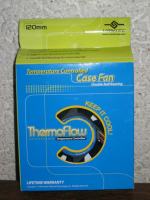
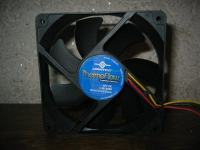
The ThermoFlow series has a temperature sensor that adjusts fan speed automatically. It's relatively silent at low temperatures but at higher temperatures it obviously becomes less silent. With an air delivery of 54.3CFM to 92CFM this fan moves a good amount of air to cool down your system.
The price of the 120mm version is about $16.
Vantec Tornado
The Tornado's really deserves its name. The amount of air moved by these fans is simple amazing. But this comes at a price: they are very loud. Let's say that they are the ultimate nightmare of people that want to get their computer system as silent as possible. With a noise level of more than 55dBA these fans sure aren't silent!
Fan controllers like the NXP-201 will be able to make them a bit more silent but they will still be louder than normal fans. But the advantage of the Tornado fans is that they really deliver a lot more air than other 'normal' fans.
The prices of the 80mm one is about $16 to $21 and the price of the 92mm one is about $17 to $23.
When it absolutely has to be cool, nothing beats the Vantec Tornado Case Fan. With airflow levels as high as 119 CFM, hot air doesn't stand a chance. Perfect for gamers and overclockers, the Vantec Tornado Case Fan is a no-compromise solution to overheated computer woes.These fans are only for hard core enthusiasts!
Specifications of the Vantec Tornado fans:
| Model: | TD8038H | TD9238H |
| Dimension: | 80X80X38 mm | 92X92X38 mm |
| Weight: | 175 g | 187 g |
| Rated Voltage: | 12V | 12V |
| Rated Power: | 9.1 W | 12.5 W |
| Rated Current: | 0.76 Amp | 1.0 Amp |
| Fan Speed: | 5700 RPM | 4800 RPM |
| Air Flow: | 84.1 CFM | 119 CFM |
| Noise: | 55.2 dB(A) | 56.4 dB(A) |
| Bearing System: | Double Ball Bearing | Double Ball Bearing |
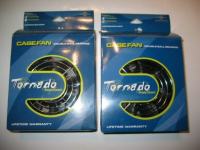
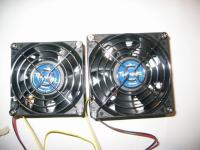
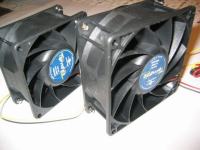
Added: October 30th 2004
Product reviewed: Vantec NXP-201 and Vantec Fans
Reviewer: LSDsmurf
Score: 8/10